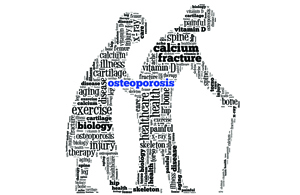Are you at risk for osteoporosis?
5/12/2025 by Sara Medina-Bielski, M.D.

Chances are that you or someone you know has or will develop osteoporosis. Osteoporosis can significantly impact your quality of life and ability to remain independent as you age. Certain factors put both women and men at greater risk for developing this disease and experiencing a fracture as a result.
What is osteoporosis?
Osteoporosis is the most common bone disease. Bones become brittle (thin) and more likely to break (fracture). They can be so weak that a minor fall or stress, such as bending over or coughing, can cause them to break. The weaker and more brittle the bones are, the higher the fracture risk. The most common fractures from osteoporosis are of the hip (femur), wrist (radius) and spine (vertebrae).
Osteoporosis develops slowly, so it is important to detect bone loss early and prevent it from progressing. Osteopenia is a related condition. With osteopenia, the bone density is lower than usual but not low enough to be called osteoporosis. People with osteopenia also are at risk for fractures, but the risk is lower than with osteoporosis.
Everyone is at risk for developing osteoporosis, although postmenopausal older women are at highest risk. Some factors are out of your control, including:
- Men and women. Women after menopause are at the highest risk.
- Race and ethnicity. White and Asian people are at higher risk than those of Hispanic/Latino, African American, African and Native-American origin.
- Age. Older age is the strongest risk factor.
- Genetics. A family history of osteoporosis or hip fracture increases your chances of having the disease.
Protecting your bones
Our bodies use calcium and phosphorus minerals to make new bone that replaces older, less healthy bone. These are factors that affect bone health that you can control:
- Vitamin D. This vitamin helps maintain a normal calcium balance. Our bodies make vitamin D but need sunlight to activate it. People who live in northern climates or spend a lot of time indoors are at high risk for vitamin D deficiency. Vitamin D is not usually found in food except for small amounts of fatty fish, along with many dairy products that are fortified with it. You can take an over-the-counter vitamin D2 or D3 supplement of 800-1,000 IU daily to reach adequate levels.
- Calcium. This mineral is found in many foods: dairy products, dark-green vegetables, beans, fish and nuts. Most adults need 1,000 mg daily; women older than 50 and men older than 70 generally need 1,200 mg daily. If you do not get enough calcium from your food, take a supplement, such as calcium carbonate or calcium citrate. Certain medications affect calcium absorption, so you may need a higher dose.
- Smoking. Tobacco use contributes to weak bones.
- Consuming alcohol. Regular consumption of more than two alcoholic drinks a day increases the risk of osteoporosis.
- Being active. Gravity keeps bones healthy, so at least 30 minutes of weight-bearing activity, such as walking daily, helps reduce the risk of osteoporosis.
- Falls. This factor is the most significant risk for fractures. Help prevent falls by being careful, paying attention, and following these guidelines:
- Wearing safe shoes, keeping laces tied.
- Reducing clutter, loose rugs and cords that could be tripped on.
- Taking care when walking on ice, snow and other slippery surfaces.
- Using a cane or walker to help with stability.
Why diagnosis is important
These statistics underscore the importance of maintaining bone health and detecting bone loss early:
- 10.2 million Americans have osteoporosis, and 43.4 million have low bone mass and are at risk for osteoporosis.
- There are more than 2 million fractures caused by osteoporosis annually.
- Osteoporosis affects both men and women; however, women are more than twice as likely to experience an osteoporosis-related fracture (approximately 70% occur in women).
Additional risk factors
If you are a woman younger than 65 or a man younger than 70 and have any of these major risk factors, you should talk with your care team about early osteoporosis testing:
- Prior low-impact fractures.
- Premature menopause due to removal of the uterus and both ovaries or loss of estrogen production at a young age.
- Medical conditions such as rheumatoid arthritis, Cushing's disease, osteogenesis imperfecta, hyperparathyroidism, hyperthyroidism (untreated), multiple myeloma or celiac disease.
- History of anorexia, malnutrition or rapid weight loss, even if current weight is normal.
- Steroid use for a long time, such as prednisone, dexamethasone or hydrocortisone. Even high doses of topical or inhaled steroids, if used for a long time, may worsen bone density.
- Weight-loss surgery.
- Anti-estrogen medications for breast cancer (tamoxifen, Arimidex, Aromasin, Femara) or anti-androgen medicines for prostate cancer (Lupron).
- Immobility, such as from paralysis, multiple sclerosis or stroke.
- History of organ transplant.
- Loss of height ≥ 4 cm (1.5 inches).
There are other risk factors for osteoporosis, although they may not call for early testing
- Long-time use of Coumadin/warfarin.
- Use of some anti-seizure medications.
- Long-time use of heartburn medications/antacids.
- Taking some oral diabetes medications for type 2 diabetes or having type 1 diabetes.
Visit the Mayo Clinic website to learn more about osteoporosis and osteopenia.
Sara Medina-Bielski, M.D., is an internist and geriatrician in Community Internal Medicine, Geriatrics and Palliative Care. She provides primary care to older adults at Mayo Family Clinic Northwest and in skilled nursing facilities in Rochester.
